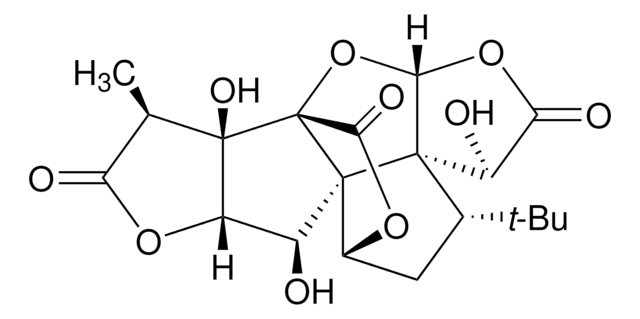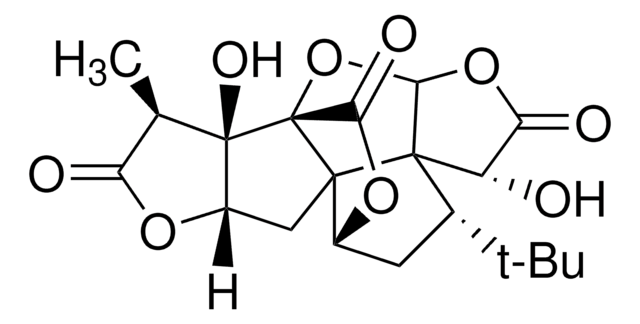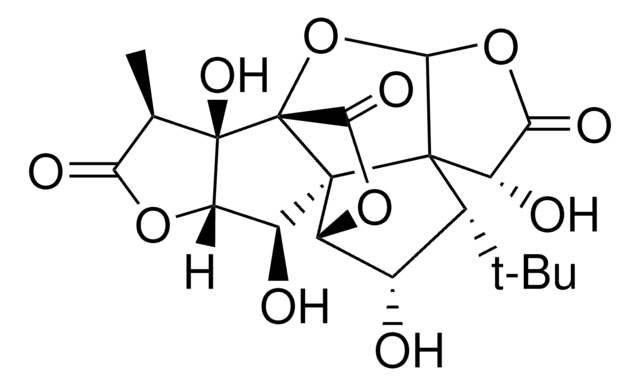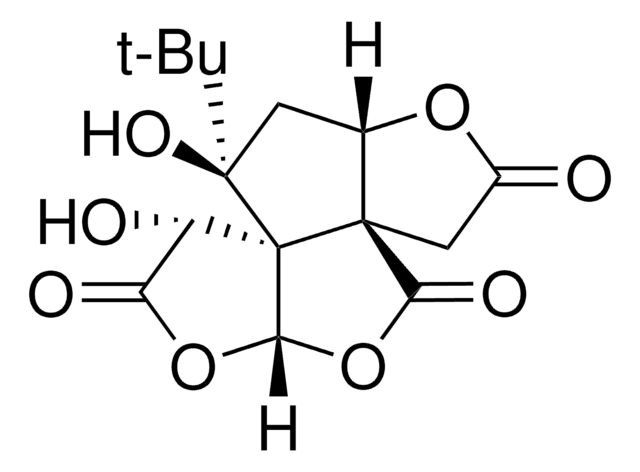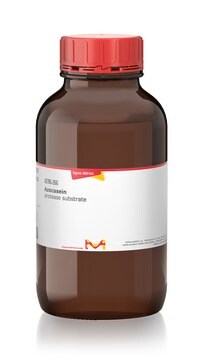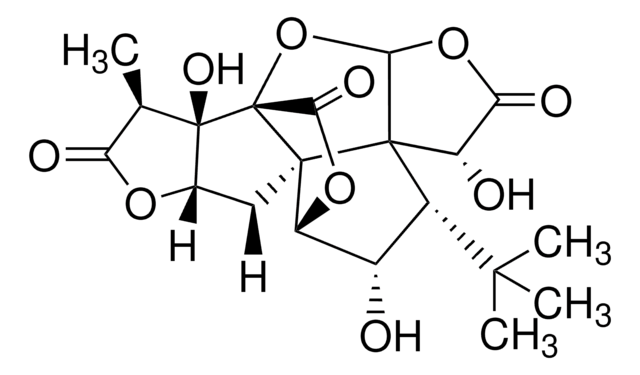B9031
(−)-Bilobalide from Ginkgo biloba leaves
≥93% (HPLC)
Sinonimo/i:
Bilobalide
Autenticatiper visualizzare i prezzi riservati alla tua organizzazione & contrattuali
About This Item
Formula empirica (notazione di Hill):
C15H18O8
Numero CAS:
Peso molecolare:
326.30
Numero MDL:
Codice UNSPSC:
85151701
ID PubChem:
NACRES:
NA.28
Prodotti consigliati
Origine biologica
plant leaves (Ginkgo biloba)
Livello qualitativo
Saggio
≥93% (HPLC)
Stato
powder
tecniche
HPLC: suitable
Colore
white
Temperatura di conservazione
−20°C
Stringa SMILE
CC(C)(C)[C@]1(O)CC2OC(=O)C[C@@]23C(=O)OC4OC(=O)[C@H](O)[C@]134
InChI
1S/C15H18O8/c1-12(2,3)14(20)4-6-13(5-7(16)21-6)10(19)23-11-15(13,14)8(17)9(18)22-11/h6,8,11,17,20H,4-5H2,1-3H3/t6-,8-,11-,13-,14+,15+/m0/s1
MOLPUWBMSBJXER-YDGSQGCISA-N
Descrizione generale
Bilobalide is a biologically active terpenic trilactone (terpenoid) extracted from Ginkgo biloba. It is synthesized from geranylgeranyl pyrophosphate (GGPP).
Applicazioni
(-)-Bilobalide from Ginkgo biloba leaves has been used as a reference substance to study the antimicrobial activity of different fractions of G.biloba leaves against a number of Gram-positive and negative bacteria and yeasts.
Azioni biochim/fisiol
Bilobalide is an inducer of cytochrome P450 enzymes CYP3A1 and CYP1A2. It exhibits neuroprotective, anti-inflammatory, anti-oxidative and anti-apoptotic properties. Bilobalide, a γ-aminobutyric acid (GABA) AA-rho, 5-hydroxytryptamine type 3 (5-HT(3)) receptor antagonist, may be used to study the function of these receptors in the brain processes such as cognition and memory. It serves as a specific platelet-activating factor receptor antagonist, which helps in the treatment of cardiovascular (Alzheimer′s disease) and cerebrovascular diseases.
Bioactive terpenoid found in Ginkgo biloba.
Codice della classe di stoccaggio
11 - Combustible Solids
Classe di pericolosità dell'acqua (WGK)
WGK 3
Punto d’infiammabilità (°F)
Not applicable
Punto d’infiammabilità (°C)
Not applicable
Dispositivi di protezione individuale
Eyeshields, Gloves, type N95 (US)
Scegli una delle versioni più recenti:
Possiedi già questo prodotto?
I documenti relativi ai prodotti acquistati recentemente sono disponibili nell’Archivio dei documenti.
I clienti hanno visto anche
Induction of cytochrome P450 3A by the Ginkgo biloba extract and bilobalides in human and rat primary hepatocytes
Zhou SF, et al.
Drug Metabolism Letters, 2(1), 60-66 (2008)
Antimicrobial investigation of semipurified fractions of Ginkgo biloba leaves
Mazzanti G, et al.
Journal of Ethnopharmacology, 71(1-2), 83-88 (2000)
Protective and therapeutic role of Bilobalide in cuprizone-induced demyelination
Sui RX, et al.
International Immunopharmacology, 66, 69-81 (2019)
Molecular cloning, characterization, and functional analysis of acetyl-CoA C-acetyltransferase and mevalonate kinase genes involved in terpene trilactone biosynthesis from Ginkgo biloba
Chen Q, et al.
Molecules (Basel), 22(1), 74-74 (2017)
Flaubert Tchantchou et al.
Journal of Alzheimer's disease : JAD, 18(4), 787-798 (2009-08-08)
Loss of synapses has been correlated with dementia in Alzheimer's disease (AD) as an early event during the disease progression. Hence, synaptogenesis and neurogenesis in adulthood could serve as a therapeutic target for the prevention and treatment of AD. Recently
Il team dei nostri ricercatori vanta grande esperienza in tutte le aree della ricerca quali Life Science, scienza dei materiali, sintesi chimica, cromatografia, discipline analitiche, ecc..
Contatta l'Assistenza Tecnica.